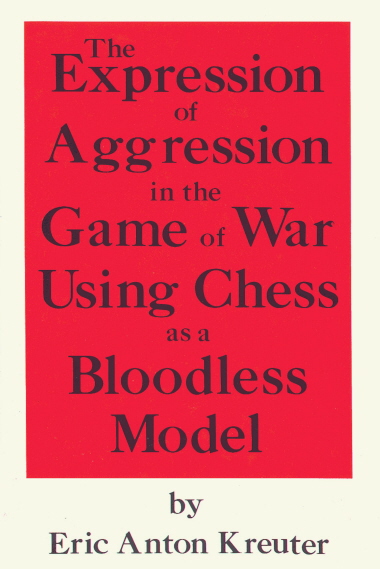
Edward Winter
(2002, with additions)

Our recent reading has included The Expression of Aggression in the Game of War Using Chess as a Bloodless Model by Eric Anton Kreuter (New York, 1991). To judge from the back cover, his qualifications for the task are two degrees (in business administration and psychology) and a track-record of having ‘authored several articles on such subjects as time management and employee motivation’.
The book’s introduction states: ‘To better study aggression as it relates to the phenomenon of war, one could look to the game of chess for insights into this form of universal human behavior’. In so doing, Kreuter relies, heavily and ill-advisedly, on Reuben Fine’s The Psychology of the Chess Player and two or three other chess books, such as The Chess Sacrifice by Vuković (whom he calls ‘Uvokovic’). Armed with this mini-library, Kreuter sets down some stunning insights:
‘War is a contest between advocates of differing views; a conflict of interests which cannot be resolved using peaceful means and usually results in a victory on one side and a defeat on the other side with heavy casualties shared by both. Therefore war is a conflict; to wage war is to engage in a forceful attempt to overthrow the enemy and move in via a takeover or a surrender by the enemy.’ (Page 27)
‘In applying the description of war to chess, it must be emphasized that any substitute for war is only a true substitute if it occurs on a much smaller scale. Chess fulfills this requirement. Chess is also a contest between two sides. The player has an opponent whom he wishes to destroy (checkmate) and against whose attacks he must defend himself. It is indeed a conflict where there is a beginning, a struggle, and an end.’ (Page 30)
‘Chess playing requires a similar deployment of strategies and tactics as in war. Certain chess games result in stalemates due to either a passive playing style or too many equal sacrifices. Stalemated chess games, like prolonged, victor-less wars result from both sides’ inability or unwillingness to execute a more aggressive style of attack.
Perhaps the same killing inhibition which stops a chessplayer from waging an all-out attack on the chessboard is affecting the society which is unable to penetrate enemy forces sufficiently enough to result in the end of the war.’ (Page 45)
By now we have quoted from the book ‘sufficiently enough’, yet it may still be wondered why Kreuter dragged chess into his analysis. The explanation on page 7 shows that his heart is in the right place:
‘To study war completely the psychologist cannot be limited to the laboratory. It is equally impossible and morally reprehensible to create an actual war between two groups of people for the purpose of conducting a field study.’
Let us at least be grateful for that.
(2832)
On the same topic see an article by Franklin K. Young, ‘Chess and War’, on pages 136-137 of American Chess World, July 1901.
A remark by Garry Kasparov in the Sunday Times magazine of 10 August 1986, page 50:
‘Chess is life in miniature. Chess is struggle, chess is battles. If you have a theory to prove, if you think you have a better position, if you think you are very strong, please use chess. It is much better than really fighting!’
From page 234 of Warriors of the Mind by Raymond Keene and Nathan Divinsky (Brighton, 1989):
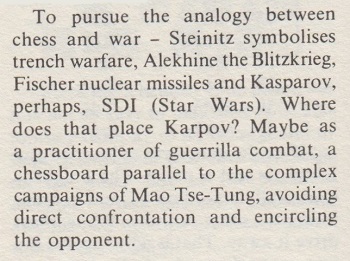
An item in Cuttings:
From page 67 of Duels of the Mind by Raymond Keene (London, 1991):
‘This incredible game has been hailed as the “Immortal Zugzwang Game”. Chess is a game symbolic of warfare. Once this is accepted, is it too fanciful to imagine that Nimzowitsch’s conduct of this wonderful game was influenced by the trench warfare, the blockades which characterized World War I?’
Yes.
C.N. 12048 referred to Raymond Keene, OBE, Ctrl+C, Ctrl+V.
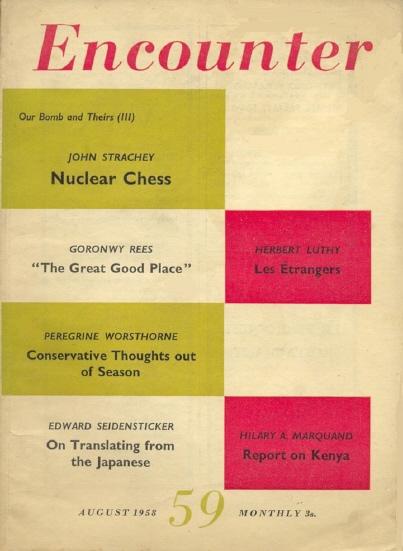
Chess was invoked for purposes of analogy in an article entitled ‘Nuclear Chess’ by John Strachey on pages 3-6 of Encounter, August 1958. It concerned the thesis of Russian aggression against the West if Russia considered that it had achieved nuclear parity:
‘It is as if, in a game of infernal chess, the two queens, i.e. the thermonuclear weapons, had been swopped at the very outset. Then, with the queens thus cancelled, the players enter into what I believe is called “the middle game”, but played, in this case, only with pawns and main pieces, i.e. conventional forces with or without tactical, or “battlefield”, nuclears. At present the Russians probably have superiority for this middle game without the thermonuclear queens.
Moreover, to pursue the chess analogy (which I do with great diffidence, being no chessplayer), there is also what I understand is called the “pawn game”. In this game, already in active play, the players clash essentially through their pawns. For this pawn game, also, conventional and not thermonuclear forces are the relevant factor.
In logic there is clearly only one Western reply to this situation, and that is to make ourselves capable of self-defence on the conventional, “middle game” level ...’
Has there been any truly successful writing which has drawn on analogies between chess and warfare?
Morgan Daniels (London) submits the passage below from pages 310-311 of an article by Jonathan Bendor and Thomas H. Hammond entitled ‘Rethinking Allison’s Models’ in the June 1992 issue of the American Political Science Review (pages 301-322). Mr Daniels recommends that the article should be read in conjunction with Graham Allison’s book Essence of Decision: Explaining the Cuban Missile Crisis (Boston, 1971).
‘Combinatorial Effects. Several times in Essence of Decision Allison uses the metaphor of chess when discussing how leaders are constrained in their choice of options. This is odd, because chess is the paradigmatic example of a choice situation that involves only a handful of basic rules yet exhibits truly Byzantine strategic complexity. There are only six distinct pieces in chess; each moves in only a few ways. (We may consider each piece, with its legal moves, as equivalent to a standard operating procedure.) Therefore, each player is “limited” to shuffling and reshuffling this combination of standard operating procedures over the 64 possible locations.
But the quantitative impression thereby conveyed, namely that the limited number of procedures creates a roughly equal (even in respect to order-of-magnitude) number of moves is grotesquely inaccurate. As is well known and as Allison himself noted, the number of possible sequences of play (i.e. behavior) in chess is staggeringly large (1971, 286, n. 93). A common estimate is 10¹²º, a number so large as to be equivalent, for all practical purposes, to infinity. Human beings can never exhaust the richness of chess. This is pure combinatorial explosion: the rules are deterministic. Nor does the complexity depend upon stochastic inputs. It is simply a matter of stringing together the handful of rules to generate new positions, whence one reapplies the basic rules, and so on. The example of chess suggests that our intuitions grossly underestimate combinatorial complexity.
Moreover, when we compare chess to the strategic maneuverings of two real military forces (to return to Essence of Decision’s empirical domain), the odds are good that chess is simpler. No matter how one counts distinct “pieces” in, say, a navy, there are surely more than seven. No matter how crudely one wants to count the basic standard operating procedures of, say, a destroyer, it has more than the handful available to even the most complex chess piece. And the “board” of any moderately large battle is more variegated than the (non-topographical) eight-by-eight chessboard. Therefore, chess, the paradigmatic choice environment of behavioral decision theory, provides a lower bound for the complexity of behavior one would expect to see in a clash between two governments. Thus, in this instance Essence of Decision seriously misapplied the lessons of the Carnegie School.’
(4754)
From page 35 of Lasker’s Chess Magazine, November 1907:
‘The comparison of chess to warfare is old and trite, yet with the changing conditions of modern times new viewpoints are continually presented. The submarine and the airship have become factors to be reckoned with and analogy to the pieces on the chessboard is obvious. In how far this analogy holds good no less an authority on both fields than Mr Rice tells in a Washington journal:
“War is becoming more and more a game of chess, a struggle of one mind against another, rather than a physical fight in which brute force wins”, said Isaac Rice, a submarine boat builder at the Shoreham last night. “The introduction of the submarine, the war balloon, which will eventually develop into a flying machine, the searchlight, with all their powers of disclosing the movements of the enemy, and the telephone into modern warfare makes the struggle between opposing forces as open as the moves on a chessboard. The element of surprise which has entered into former wars, to a large extent, is gradually being eliminated. Each commander will know the position of the forces of the enemy, and the victory will go to the man who best lays his plans to checkmate the other.
This reduction of warfare more and more to an exact science and the use of submarine and airships will undoubtedly make the forces employed against each other smaller. Huge armies are hard to handle and to provision. Undoubtedly, too, the sacrifice of life will be less. Battles are fought and won at the army maneuvers as now conducted without the firing of a shot. Judges decide that one force has placed itself in a position to annihilate the other. Generals in actual warfare will recognize this fact, too.”’
We should like to discover the exact source regarding the ‘Washington journal’. C.N. 2823 (see page 316 of Chess Facts and Fables) quoted a paragraph by Emanuel Lasker about Rice’s military prophecies, from page 67 of The Community of the Future (New York, 1940):
‘It is about 30 and some years ago that Isaac L. Rice, the builder of submarine vessels, in a talk with me predicted the coming of the age when technological invention would supersede the niceties of military strategy. He mentioned big, long range, accurately aimed guns and the possibilities of bombing. If he lived today, he would probably specify his prophecy still further. The evolution in the direction of military equipment is almost automatic. To bend the discoveries and conquests of the intellect towards a destructive purpose is easier by far than to develop them in their constructive ethical direction.’
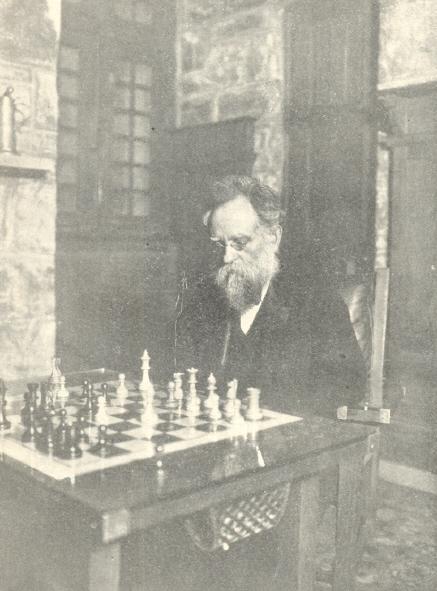
Isaac Leopold Rice
(4787)
From an unattributed article entitled ‘Chess’ on pages 464-469 of
the Rhode-Island Literary Repository, December 1814: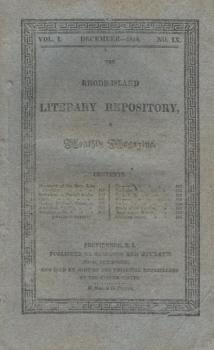
‘A game of chess is also a tolerably correct representation of two armies at war. The object of each party in both cases is the same, the destruction of the other. Or, at least, its defeat, which can never be effected without partial, and often proves nearly as bad as total, destruction. The methods pursued to obtain this object are also very much alike, differing only with the character of different performers. That activity, regularity and proper disposition of forces, which are indispensably necessary in the one are also the life and soul of the other. And indolence, confusion and disorder are equally injurious in both. As in war, offensive measures are almost invariably more profitable than defensive; so in chess, he who extends the sphere of operations as far from home as possible is generally successful, while he who suffers his own territories to be made the theatre of action is usually soon defeated. This game affords ample room for all those surprises, ambuscades and stratagems which are practised with such advantage by many generals. Here too may frequently be seen those desperate and destructive battles which sometimes take place between despair on the one hand and grief and rage on the other. It is also equally true in warfare and in chess that those attacks which are commenced without sufficient preparation are usually ineffectual, productive of injury rather than profit; and that those which are divided, partial and consequently feeble tend only to weaken the party who makes them, and strengthen the opposite. But the assaults which are made with full and united strength seldom fail of great execution.
As the just fame of the warriour is founded not in the destruction but in the saving of the human kind – so that of the chessplayer consists not so much in capturing the forces of his adversary as in effecting his own purpose with as little loss as possible.
Hansing and his army no doubt improved themselves in the art of war by the exercise of chess; for, in practising it, may be displayed the calmness, the contempt of fame, the discretion and the perseverance of a Fabius; the folly, the rashness and the impetuosity of a Minucius; the humanity, the amiability and the magnanimity of a Henry fourth; or the haughtiness, the obstinacy, the heroism and the foolhardiness of Sweden’s twelfth Charles.’
(4957)
Morgan Daniels quotes from pages 80 and 82 of Bronowski’s book The Ascent of Man (London, 1973):
‘In a sense, warfare was created by the horse, as a nomad activity. That is what the Huns brought, that is what the Phrygians brought, that is what finally the Mongols brought, and brought to a climax under Genghis Khan much later. In particular, the mobile hordes transformed the organization of battle. They conceived a different strategy of war – a strategy that is like a war game; how warmakers love to play games!
The strategy of the mobile horde depends on manoeuvre, on rapid communication, and on practised tactical moves which can be strung together into different sequences of surprise. The remnants of that remain in the war games that are still played and that come from Asia, such as chess and polo. War strategy is always regarded by those who win as a kind of game.’
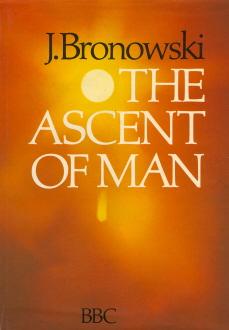
(4998)
A number of C.N. items have discussed chess and war, and here we add that another article on the subject appeared on pages 6-7 of the January 1916 BCM: a report on a lecture ‘Analogies between Chess and War’ delivered by Herbert Jacobs at the Hampstead Chess Club on 23 October 1915. However, it all seems rather facile, and we are still looking for an in-depth treatment of the subject.
(5253)
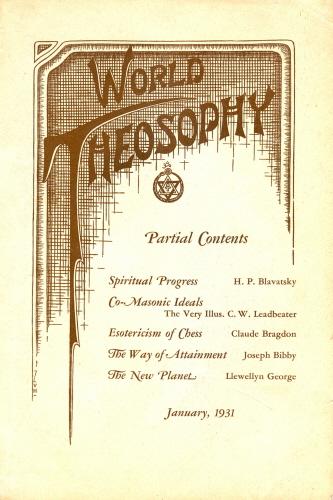
From an article entitled ‘The Esotericism of Chess’ by Claude Bragdon on pages 21-23 of World Theosophy, January 1931:
‘Chess strategy is like war strategy: in both, speed of mobilization is a determining factor; a pawn salient is like an infantry salient, pushing into the enemy country like a wedge, with flanks resting on strongholds; in both, feint and surprise attacks play an important part. Indeed, the parallel is in all ways so perfect that my friend Gelett Burgess once drew a map of a battlefield and described at great length the engagement fought thereon, and it is only at the end that the reader is permitted to discover that the whole thing is a detailed description of one of Paul Morphy’s most celebrated chess games in terms of military action. For any chess game can be described in terms of warfare and any military campaign can be re-enacted, after a fashion, with chessmen on a board.
And oddly enough, championship chess has changed in the same way as has warfare, which is no longer a thing of long-distance raids, cut off from supply bases, of brilliant cavalry charges, but is a matter of “digging in” – wars now are wars of attrition. Similarly, chess masters no longer play the old-fashioned open game, having abandoned it in favor of tactics quite similar to trench warfare. This has resulted in an increasing number of drawn games – so many, in fact, that it has been suggested that the game be made more difficult by increasing the size of the board and the number of pieces. The logical ultimate of this, as the human mind grows more four-dimensional, would be the substitution of “cubical” chess – the addition of another dimension, though now the brain reels at the very suggestion.’
(5786)
C.N. 4297 noted that the entry on Löwenthal on page 122 of the Dictionary of Modern Chess by Byrne J. Horton (New York, 1959) stated:
‘One of Löwenthal’s famous quotations is: “The judicious violation of general principles marks the master-mind”.’
The exact source of the observation was requested, and we now see the following (a game between Morphy and Julien) on page 415 of Morphy’s Games of Chess by J. Löwenthal (London, 1860):
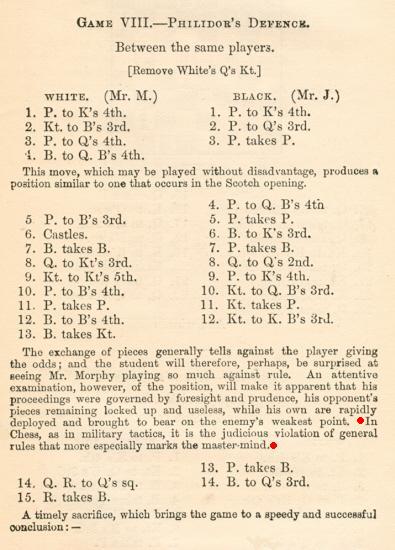
The wording is thus slightly different: ‘In Chess, as in military tactics, it is the judicious violation of general rules that more especially marks the master-mind.’
(6581)
A sketch on page 297 of the Illustrated London News, 9 March 1940:
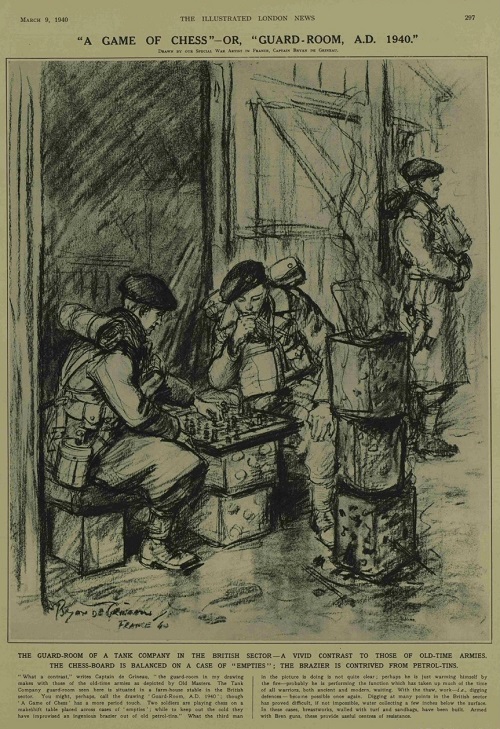
The picture was reproduced on page 161 of CHESS, April 1940.
(10994)
Addition on 11 March 2024:
The Bogoljubow v Trott game is used, with colours reversed, in the 2023 animated short film War Is Over! directed by Dave Mullins and co-written by him and Sean Ono Lennon. We proposed the 1950 game to him when he requested an illustration of the theme of check followed by immediate checkmate.
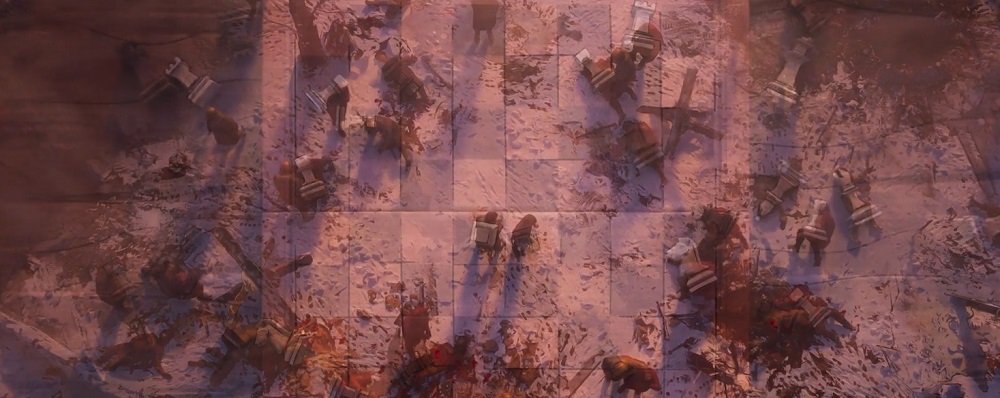
A still from War Is Over! (reproduced with permission)
At the Academy Awards ceremony in Los Angeles on 10 March 2024, War Is Over! won the Oscar in the category ‘Best Animated Short Film’.
An item on page 153 of the July 1912 American Chess Bulletin:
‘An incident of the Boer War
P.A. Hatchard of Albany, NY favors us with the following touching incident from the Boer war:
Following one of the many engagements that took place in this war, when the usual rounds were made to ascertain the number of the killed and wounded, there was found placed on the knapsack of one of the former a single chess pawn, the wounded man having evidently withdrawn it from the box he carried and placed it in that conspicuous position ere he succumbed. Many papers at that period commented on this simple act as being a silent interpreter of the poor soldier’s thoughts, comparing himself to a lowly pawn in the great and terrible game of war.’
(12039)
From Lord Dunsany and Chess:

BCM, April 1943, page 74 (C.N. 661)
Addition on 26 December 2024:
From Emanuel Lasker’s column in the New York Evening Post, 3 July 1907, page 4:
‘Chessplayers soon learn to know that the mere possession of superior material is not sure to bring success. For superior force to exercise the function which is inherent in it, it must be within reach and have access to the field of operations. On the other hand, a weaker force may succeed if it can exert pressure on a vital spot before reinforcements arrive. Russia, for instance with her vast resources, succumbed to Japan, because it could not bring those resources to bear on the field of operations. And a handful of Boer farmers could withstand the power of the British Empire for years for a similar reason.’
To the Chess Notes main page.
To the Archives for other feature articles.
Copyright: Edward Winter. All rights reserved.